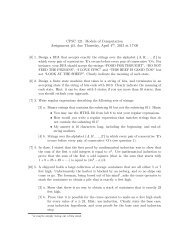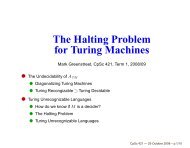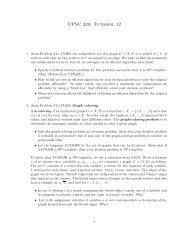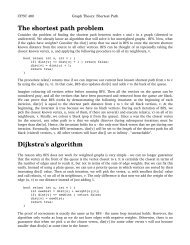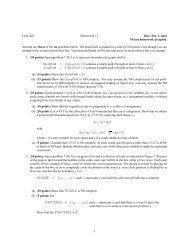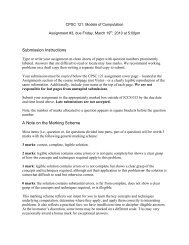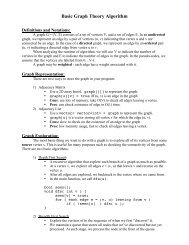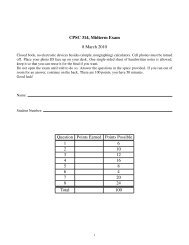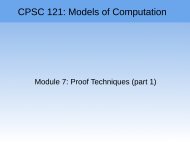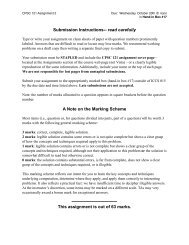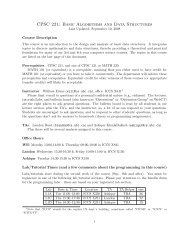Big-O Notation Lecture Slides - Ugrad.cs.ubc.ca
Big-O Notation Lecture Slides - Ugrad.cs.ubc.ca
Big-O Notation Lecture Slides - Ugrad.cs.ubc.ca
You also want an ePaper? Increase the reach of your titles
YUMPU automatically turns print PDFs into web optimized ePapers that Google loves.
CS221: Algorithms and<br />
Data Structures<br />
<strong>Big</strong>-O<br />
Alan J. Hu<br />
(Borrowing some slides from Steve Wolfman)<br />
1
Learning Goals<br />
• Define big-O, big-Omega, and big-Theta: O(•), (•), (•)<br />
• Explain intuition behind their definitions.<br />
• Prove one function is big-O/Omega/Theta of another<br />
function.<br />
• Simplify algebraic expressions using the rules of<br />
asymptotic analysis.<br />
• List common asymptotic complexity orders, and how they<br />
compare.<br />
• Work some examples.<br />
2
Asymptotic Analysis of Algorithms<br />
From last time, some key points:<br />
• We will measure runtime, or memory usage, or<br />
whatever we are comparing, as a function in<br />
terms of n.<br />
• Be<strong>ca</strong>use we are comparing algorithms, we only<br />
count “basic operations”, and since we don’t know<br />
how long each basic operation will really take, we<br />
ignore constant factors.<br />
• We focus only on when n gets big.
Asymptotic Analysis of Algorithms<br />
From last time, some key points:<br />
• We will measure runtime, or memory usage, or<br />
whatever we are comparing, as a function in<br />
terms of n.<br />
• Be<strong>ca</strong>use we are comparing algorithms, we only<br />
count “basic operations”, and since we don’t know<br />
how long each basic operation will really take, we<br />
ignore constant factors.<br />
• We focus only on when n gets big.
Runtime Smackdown!<br />
Alan’s Old Thinkpad x40<br />
• Older Laptop<br />
• Pentium M 32bit CPU at<br />
1.4Ghz<br />
• 1.5 GB of RAM<br />
Pademelon<br />
• 2011 Desktop PC<br />
• Core i7-870 64bit CPU at<br />
3Ghz w/ TurboBoost<br />
• 16GB of RAM<br />
Which computer is faster? By how much?
Runtime Smackdown II!<br />
Tandy 200<br />
• 1984 Laptop<br />
• Intel 8085 8bit CPU at<br />
2.4Mhz<br />
• 24KB of RAM<br />
• Interpreted BASIC<br />
Pademelon<br />
• 2011 Desktop PC<br />
• Core i7-870 64bit CPU at<br />
3Ghz w/ TurboBoost<br />
• 16GB of RAM<br />
• Compiled C++<br />
Which computer is faster? By how much?
Runtime Smackdown III!<br />
Tandy 200<br />
• 1984 Laptop<br />
• Intel 8085 8bit CPU at<br />
2.4Mhz<br />
• 24KB of RAM<br />
• Interpreted BASIC<br />
Pademelon<br />
• 2011 Desktop PC<br />
• Core i7-870 64bit CPU at<br />
3Ghz w/ TurboBoost<br />
• 16GB of RAM<br />
• Compiled C++<br />
Which computer is faster? By how much?<br />
But what if we run asymptoti<strong>ca</strong>lly different algorithms?
Asymptotic Analysis of Algorithms<br />
From last time, some key points:<br />
• We will measure runtime, or memory usage, or<br />
whatever we are comparing, as a function in<br />
terms of n.<br />
• Be<strong>ca</strong>use we are comparing algorithms, we only<br />
count “basic operations”, and since we don’t know<br />
how long each basic operation will really take, we<br />
ignore constant factors.<br />
• We focus only on when n gets big.
Post #1<br />
n 3 + 2n 2<br />
n 0.1<br />
n + 100n 0.1<br />
5n 5<br />
n -15 2 n /100<br />
82lg n<br />
mn 3<br />
Silicon Downs<br />
Post #2<br />
100n 2 + 1000<br />
log n<br />
2n + 10 log n<br />
n!<br />
1000n 15<br />
3n 7 + 7n<br />
2 m n<br />
For each race,<br />
which “horse”<br />
grows bigger as n<br />
goes to infinity?<br />
(Note that in<br />
practice, smaller<br />
is better.)<br />
a.Left<br />
b.Right<br />
c.Tied<br />
d.It depends<br />
e.I am opposed to<br />
algorithm racing.<br />
9
Race I<br />
a. Left<br />
b. Right<br />
c. Tied<br />
d. It depends<br />
n 3 + 2n 2 100n 2 + 1000<br />
vs.<br />
10
Race II<br />
n 0.1 log n<br />
vs.<br />
a. Left<br />
b. Right<br />
c. Tied<br />
d. It depends<br />
11
Race III<br />
a. Left<br />
b. Right<br />
c. Tied<br />
d. It depends<br />
n + 100n 0.1 2n + 10 log n<br />
vs.<br />
12
Race IV<br />
5n 5 n!<br />
vs.<br />
a. Left<br />
b. Right<br />
c. Tied<br />
d. It depends<br />
13
Race V<br />
a. Left<br />
b. Right<br />
c. Tied<br />
d. It depends<br />
n -15 2 n /100 1000n 15<br />
vs.<br />
14
Race VI<br />
a. Left<br />
b. Right<br />
c. Tied<br />
d. It depends<br />
8 2lg(n) 3n 7 + 7n<br />
vs.<br />
15
Race VII<br />
mn 3 2 m n<br />
vs.<br />
a. Left<br />
b. Right<br />
c. Tied<br />
d. It depends<br />
16
Post #1<br />
n 3 + 2n 2<br />
n 0.1<br />
n + 100n 0.1<br />
5n 5<br />
n -15 2 n /100<br />
82lg n<br />
mn 3<br />
Silicon Downs<br />
Post #2<br />
100n 2 + 1000<br />
log n<br />
2n + 10 log n<br />
n!<br />
1000n 15<br />
3n 7 + 7n<br />
2 m n<br />
Grows <strong>Big</strong>ger<br />
n 3 + 2n 2<br />
n 0.1<br />
2n + 10 log n (tied)<br />
n!<br />
n -15 2 n /100<br />
3n 7 + 7n<br />
IT DEPENDS 17
Order <strong>Notation</strong><br />
• We’ve seen why focus on dealing with big inputs.<br />
• We modeled that formally as the asymptotic<br />
behavior, as input size goes to infinity.<br />
• We looked at a bunch of Steve’s “races”, to see<br />
which function “wins” or “loses”.<br />
• How do we formalize the notion of winning? How<br />
do we formalize that one function “eventually<br />
<strong>ca</strong>tches up and grows faster”?<br />
18
Order <strong>Notation</strong><br />
• We’ve seen why focus on dealing with big inputs.<br />
• We modeled that formally as the asymptotic<br />
behavior, as input size goes to infinity.<br />
• We looked at a bunch of Steve’s “races”, to see<br />
which function “wins” or “loses”.<br />
• How do we formalize the notion of winning? How<br />
do we formalize that one function “eventually<br />
<strong>ca</strong>tches up and grows faster”?<br />
19
Race I<br />
a. Left<br />
b. Right<br />
c. Tied<br />
d. It depends<br />
n 3 + 2n 2 100n 2 + 1000<br />
vs.<br />
20
Race II<br />
n 0.1 log n<br />
vs.<br />
a. Left<br />
b. Right<br />
c. Tied<br />
d. It depends<br />
21
Race III<br />
a. Left<br />
b. Right<br />
c. Tied<br />
d. It depends<br />
n + 100n 0.1 2n + 10 log n<br />
vs.<br />
22
How to formalize winning?<br />
• How to formally say that there’s some crossover<br />
point, after which one function is bigger than the<br />
other?<br />
• How to formally say that you don’t <strong>ca</strong>re about a<br />
constant factor between the two functions?
Order <strong>Notation</strong> – <strong>Big</strong>-O<br />
• T(n) O(f(n)) if there are constants c and n 0 such<br />
that T(n) c f(n) for all n n 0<br />
24
Order <strong>Notation</strong> – <strong>Big</strong>-O<br />
• T(n) O(f(n)) if there are constants c and n 0 such<br />
that T(n) c f(n) for all n n 0<br />
• Why the n0 ?<br />
• Why the c ?<br />
25
Order <strong>Notation</strong> – <strong>Big</strong>-O<br />
• T(n) O(f(n)) if there are constants c and n 0 such<br />
that T(n) c f(n) for all n n 0<br />
• Why the ?<br />
(Many people write T(n)=O(f(n)),<br />
but this is sloppy. The shows you why<br />
you should never write O(f(n))=T(n),<br />
with the big-O on the left-hand side.)<br />
26
Order <strong>Notation</strong> – <strong>Big</strong>-O<br />
• T(n) O(f(n)) if there are constants c and n 0 such<br />
that T(n) c f(n) for all n n 0<br />
• Intuitively, what does this all mean?<br />
27
Order <strong>Notation</strong> – <strong>Big</strong>-O<br />
• T(n) O(f(n)) if there are constants c and n 0 such<br />
that T(n) c f(n) for all n n 0<br />
• Intuitively, what does this all mean?<br />
The function f(n) is sort of, asymptoti<strong>ca</strong>lly “greater<br />
than or equal to” the function T(n).<br />
In the “long run”, f(n) (multiplied by a suitable<br />
constant) will upper-bound T(n).<br />
28
Order <strong>Notation</strong> – <strong>Big</strong>-Theta and<br />
<strong>Big</strong>-Omega<br />
• T(n) O(f(n)) if there are constants c and n0 such<br />
that T(n) c f(n) for all n n0 • T(n) (f(n)) if f(n) O(T(n))<br />
• T(n) (f(n)) if T(n) O(f(n)) and T(n) (f(n)) 29
Examples<br />
10,000 n2 + 25 n (n2 )<br />
10-10 n2 (n2 )<br />
n log n O(n2 )<br />
n log n (n) n3 + 4 O(n4 ) but not (n4 )<br />
n3 + 4 (n2 ) but not (n2 )<br />
30
Proofs?<br />
10,000 n2 + 25 n (n2 )<br />
10-10 n2 (n2 )<br />
n log n O(n2 )<br />
n log n (n) n3 + 4 O(n4 ) but not (n4 )<br />
n3 + 4 (n2 ) but not (n2 )<br />
How do you prove a big-O? a big- ? a big- ?<br />
31
Proving a <strong>Big</strong>-O<br />
• T(n) O(f(n)) if there are constants c and n 0 such<br />
that T(n) c f(n) for all n n 0<br />
• Formally, to prove T(n) O(f(n)), you must show:<br />
, n n n<br />
0 0<br />
T ( n)<br />
cf ( n)<br />
<br />
c<br />
<br />
• How do you prove a “there exists” property?<br />
32
Proving a “There exists” Property<br />
How do you prove “There exists a good restaurant in<br />
Vancouver”?<br />
How do you prove a property like<br />
3 1<br />
c c c<br />
33
Proving a <br />
Property<br />
How do you prove “There exists a restaurant in<br />
Vancouver, where all items on the menu are less<br />
than $10”?<br />
How do you prove a property like<br />
cx c x<br />
2<br />
<br />
10<br />
34
Proving a <strong>Big</strong>-O<br />
Formally, to prove T(n) O(f(n)), you must show:<br />
, n n n<br />
0 0<br />
T ( n)<br />
cf ( n)<br />
<br />
c<br />
<br />
So, we have to come up with specific values of c and<br />
n 0 that “work”, where “work” means that for any<br />
n>n 0 that someone picks, the formula holds:<br />
T ( n)<br />
<br />
cf ( n)<br />
<br />
35
Proving <strong>Big</strong>-O -- Example<br />
10,000 n2 + 25 n (n2 )<br />
10-10 n2 (n2 )<br />
n log n O(n2 )<br />
n log n (n) n3 + 4 O(n4 ) but not (n4 )<br />
n3 + 4 (n2 ) but not (n2 )<br />
36
Prove n log n O(n 2 )<br />
• Guess or figure out values of c and n0 that will<br />
work.<br />
(Let’s assume base-10 logarithms.)
Prove n log n O(n 2 )<br />
• Guess or figure out values of c and n0 that will<br />
work.<br />
(Let’s assume base-10 logarithms.)<br />
• Turns out c=1 and n0 = 1 works!<br />
(What happens if you guess wrong?)
Prove n log n O(n 2 )<br />
• Guess or figure out values of c and n0 that will<br />
work.<br />
(Let’s assume base-10 logarithms.)<br />
• Turns out c=1 and n0 = 1 works!<br />
• Now, show that n log n 1
Prove n log n O(n 2 )<br />
• Guess or figure out values of c and n0 that will<br />
work.<br />
(Let’s assume base-10 logarithms.)<br />
• Turns out c=1 and n0 = 1 works!<br />
• Now, show that n log n 1<br />
• This is fairly trivial: log n 1)<br />
Multiply both sides by n (OK, since n>1>0)
Aside: Writing Proofs<br />
• In lecture, my goal is to give you intuition.<br />
– I will just sketch the main points, but not fill in all<br />
details.<br />
• When you write a proof (homework, exam,<br />
reports, papers), be sure to write it out formally!<br />
– Standard format makes it much easier to write!<br />
• Class website has links to notes with standard tricks, examples<br />
• Textbook has good examples of proofs, too.<br />
• Copy the style, structure, and format of these proofs.<br />
– On exams and homeworks, you’ll get more credit.<br />
– In real life, people will believe you more.
To Prove n log n O(n 2 )<br />
Proof:<br />
By the definition of big-O, we must find values of c and n0 such that for all n n0, n log n cn2 .<br />
Consider c=1 and n0 = 1.<br />
For all n 1, log n n.<br />
Therefore, log n cn, since c=1.<br />
Multiplying both sides by n (and since n n0= 1), we have n<br />
log n cn2 .<br />
Therefore, n log n O(n2 ).<br />
QED<br />
(This is more detail than you’ll use in the future, but<br />
until you learn what you <strong>ca</strong>n skip, fill in the details.)
Proving <strong>Big</strong>-<br />
• Just like proving <strong>Big</strong>-O, but backwards…
Proving <strong>Big</strong>-<br />
• Just prove <strong>Big</strong>-O and <strong>Big</strong>-
Proving <strong>Big</strong>- -- Example<br />
10,000 n2 + 25 n (n2 )<br />
10-10 n2 (n2 )<br />
n log n O(n2 )<br />
n log n (n) n3 + 4 O(n4 ) but not (n4 )<br />
n3 + 4 (n2 ) but not (n2 )<br />
45
Prove 10,000 n 2 + 25 n O(n 2 )<br />
• What values of c and n 0 work?<br />
(Lots of answers will work…)
Prove 10,000 n 2 + 25 n O(n 2 )<br />
• What values of c and n0 work?<br />
I’ll use c=10025 and n0 = 1.<br />
10,000 n2 + 25 n
Prove 10,000 n 2 + 25 n (n 2 )<br />
• What is this in terms of <strong>Big</strong>-O?
Prove n 2 O(10,000 n 2 + 25 n)<br />
• What values of c and n 0 work?
Prove n 2 O(10,000 n 2 + 25 n)<br />
• What values of c and n0 work?<br />
I’ll use c=1 and n0 = 1.<br />
n2
Mounties Find Silicon Downs Fixed<br />
• The fix sheet (typi<strong>ca</strong>l growth rates in order)<br />
– constant: O(1)<br />
– logarithmic: O(log n) (logkn, log n2 O(log n))<br />
– poly-log: O(logk n) (k is a constant >1)<br />
– linear: O(n)<br />
– (log-linear): O(n log n) (usually <strong>ca</strong>lled “n log n”)<br />
– (superlinear): O(n1+c ) (c is a constant, 0 < c < 1)<br />
– quadratic: O(n2 )<br />
– cubic: O(n3 )<br />
– polynomial: O(nk ) (k is a constant)<br />
– exponential: O(cn “tractable”<br />
) (c is a constant > 1)<br />
51<br />
“intractable”
Asymptotic Analysis Hacks<br />
• These are quick tricks to get big- <strong>ca</strong>tegory.<br />
• Eliminate low order terms<br />
– 4n + 5 4n<br />
– 0.5 n log n - 2n + 7 0.5 n log n<br />
–2n + n3 + 3n 2n • Eliminate coefficients<br />
– 4n n<br />
– 0.5 n log n n log n<br />
– n log (n2 ) = 2 n log n n log n<br />
52
Log Aside<br />
logab means “the exponent that turns a into b”<br />
lg x means “log2x” (our usual log in CS)<br />
log x means “log10x” (the common log)<br />
ln x means “logex” (the natural log)<br />
But… O(lg n) = O(log n) = O(ln n) be<strong>ca</strong>use:<br />
logab = logcb / log<strong>ca</strong> (for c > 1)<br />
so, there’s just a constant factor between log bases<br />
53
USE those cheat sheets!<br />
• Which is faster, n 3 or n 3 log n?<br />
• Which is faster, n 3 or n 3.01 /log n?<br />
(Split it up and use the “dominance” relationships.)<br />
54
Rates of Growth<br />
• Suppose a computer executes 10 12 ops per second:<br />
n = 10 100 1,000 10,000 10 12<br />
n 10 -11 s 10 -10 s 10 -9 s 10 -8 s 1s<br />
n log n 10 -11 s 10 -9 s 10 -8 s 10 -7 s 40s<br />
n 2 10 -10 s 10 -8 s 10 -6 s 10 -4 s 10 12 s<br />
n 3<br />
2 n<br />
10 -9 s 10 -6 s 10 -3 s 1s 10 24 s<br />
10 -9 s 10 18 s 10 289 s<br />
10 4 s = 2.8 hrs 10 18 s = 30 billion years<br />
55



